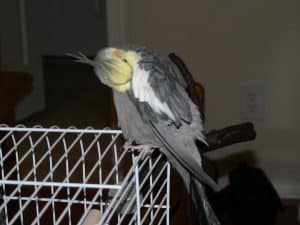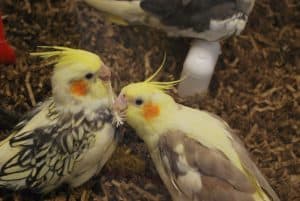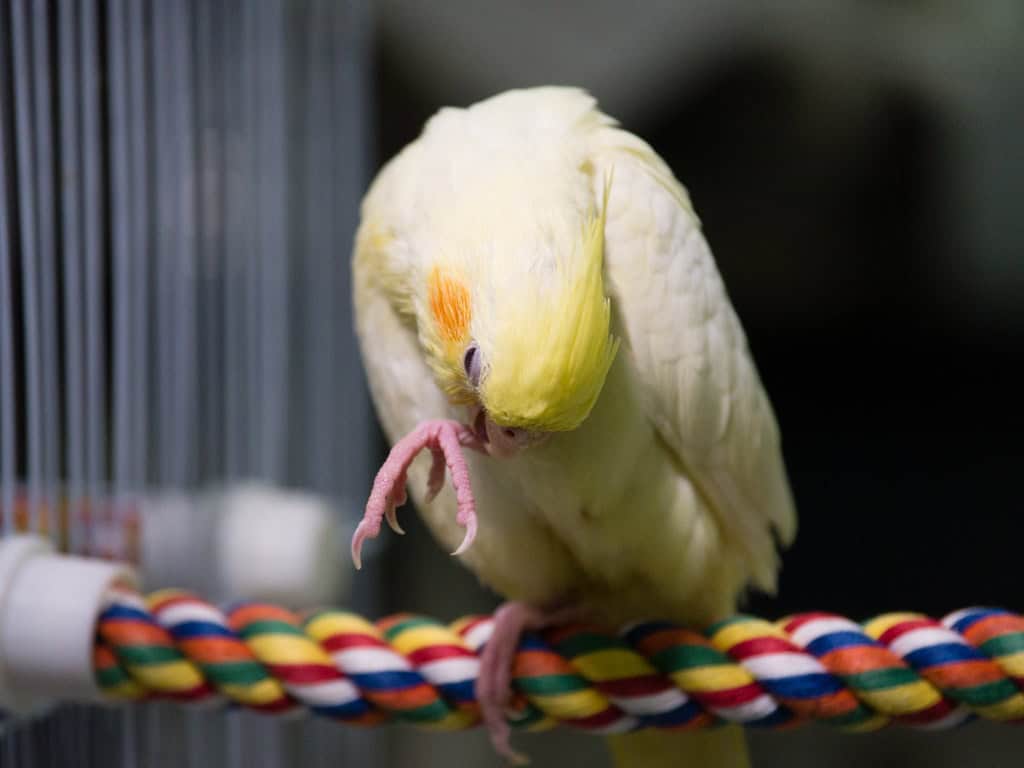Keeping your cockatiel looking sharp isn’t just about aesthetics—it’s essential for their health and happiness. Cockatiel grooming routines, will guide you through the simple yet effective steps to ensure your feathered friend stays in top condition.
Importance of Cockatiel Grooming
Regular grooming ensures your cockatiel’s health and well-being. Routine care, such as feather maintenance and nail trimming, helps prevent unhealthy plumage and other health issues. When you include grooming schedules in their care routine, you significantly contribute to their overall happiness and longevity.
Clean and well-maintained feathers impact your bird’s ability to fly and regulate body temperature. When your bird’s feathers are in good condition, it aids in their agility and flight control, crucial for their safety. Avian vets recommend using a fine mist spray or placing a shower perch in a sunlit window to maintain your cockatiel’s feathers.
Nail clipping is essential for your cockatiel’s foot health. Overgrown nails can cause difficulty in perching and may result in injuries. Use proper tools, like baby nail clippers or bird claw clippers, to ensure safety during the process. If you’re unsure or uncomfortable with grooming, consult avian veterinarians or pet stores for professional advice.
Daily Grooming Tasks

Daily grooming tasks ensure your cockatiel remains healthy and happy. Consistent maintenance of their feathers and nails is essential.
Morning Routine
Start your morning by examining your cockatiel’s feathers. Check for unhealthy plumage and remove any damaged or molting feathers. A fine mist spray helps maintain feather quality, especially before the bird’s morning activity. Ensure the bird’s cage is clean and sanitary every morning. Place a bowl filled halfway with fresh water for your bird’s bath. Clean water encourages natural grooming behaviors and keeps feathers in optimal condition.
Midday Check
Perform a midday check to monitor your cockatiel’s overall well-being. Inspect your bird’s feet for dirt or debris and use mild glycerin soap for gentle cleaning if necessary. Observe your bird’s path in the cage to ensure there are no obstructions or hazards. Check your cockatiel’s diet by replacing any uneaten food and adding fresh produce. Proper nutrition supports feather and nail health.
Evening Routine
End the day by inspecting your cockatiel’s nails and trimming if needed. Use a bird claw clipper, following the natural dividing point between the quick and tip, to avoid cutting a fine blood vessel. Dim the lights smoothly to simulate a sun lit window; darkness encourages rest. Allow your bird to preen its plumage on a shower perch or inside a calm, quiet area. Keep a cockatiel first aid kit accessible for any immediate needs. Regular care leads to a happier and healthier pet.
Weekly Grooming Tasks

Feather Maintenance
Inspect and clean your cockatiel’s feathers weekly. Regularly cleaning prevents unhealthy plumage and ensures optimal flight. Use a fine mist spray bottle filled with lukewarm water and a mild glycerin soap to lightly mist your bird. This helps remove excess bird’s powder. Avoid using poor boiling water as it can harm the bird’s feathers and skin. Provide a shower perch so your cockatiel can bathe comfortably. This simulates natural rainfall and keeps feathers clean and conditioned.
Nail Trimming
Trim your cockatiel’s nails weekly. Overgrown nails can cause discomfort and interfere with perching. Use a bird claw clipper or baby nail clipper, as these tools are designed for precision. Gently hold the bird’s foot and clip the nails carefully, avoiding the fine blood vessel visible inside each nail. This prevents bleeding and ensures the process is painless for your feathered friend. If unsure, consult avian vets for guidance.
Wing Clipping
Assess and clip your pet cockatiel’s wings if needed. Wing clipping helps control the bird’s flight path, ensuring safety within the home. Focus on trimming the primary feathers, which are the main flight feathers. Be cautious of blood feathers, or pin feathers, which contain fine blood vessels. It’s advisable to clip only one wing to cause a slight imbalance, making it difficult for the bird to gain altitude. Seek advice from avian veterinarians or cockatiel breeders to avoid improper clipping.
Nail Trimming
Regular nail trimming is essential in your cockatiel grooming routine, ensuring your bird remains comfortable and healthy.
Step-by-Step Guide
- Gather Supplies: Use bird claw clippers or small cat claw clippers for precision. Keep styptic powder handy to stop bleeding if you cut too close to a fine blood vessel.
- Inspect Nails: Notice the slight inward dip where the nail curls. This is the natural dividing point between the live tissue and the nail tip, where trimming is safe.
- Sit Steady: Hold the bird steady with its cockatiel’s wings clipped if it feels more secure. Position your cockatiel’s foot firmly but gently, keeping the bird’s direction stable.
- Trim Carefully: Trim only the pointed tip of the nail. Avoid the quick, visible in light-colored cockatiels as a dark center in the nail.
Regular nail maintenance prevents injuries and discomfort, making it a crucial part of cockatiel grooming.
- Stay Calm: Ensure a quiet environment to keep your bird relaxed. A sun-lit window provides natural light for better visibility during trimming.
- Quick Check: Have styptic powder ready, but don’t use it as a regular procedure. Only apply it if you trim too close to a fine blood vessel.
- Professional Help: Contact avian veterinarians if you’re unsure about nail trimming. Avian vets can show you proper techniques to avoid harming your cockatiel.
Proper nail care ensures your cockatiel’s feet remain healthy, leading to better overall health and comfort.
- PREMIUM BLEND of seeds and Natural FruitBlend Pellets to provide your bird a sensible way to indulge in a seed mix.
- Made specifically for Lovebirds, Quakers, Small Conures and Cockatiels. This blend includes a delicious mix of right-sized pieces for your bird which helps minimize wasted food.
- Feed Sensible Seed to help satisfy your birds playful and fun-loving instincts and help create an interactive activity with each feeding.
- ADD ENRICHING VARIETY to your birds weekly food program. May be fed up to 30 percent of the total food your bird eats each week.
- CONVERT YOUR BIRD TO A HEALTHIER DIET. Converting your bird to a food that includes pellets is worth the effort for his/her health and wellbeing.
Beak Care
Beak care is vital in your cockatiel grooming routine to maintain your bird’s health and well-being. Use the following steps to ensure your pet’s beak remains in top condition.
- Regular Inspection
Check the beak weekly for cracks or overgrowth. Overgrown beaks can cause difficulty eating and may indicate an underlying health issue. Monitor the beak’s color and texture, especially if you have light-colored cockatiels, as these can signal nutritional deficiencies. - Provide Beak-Trimming Tools
Offer your cockatiel items to naturally wear down their beak. Use cuttlebones, mineral blocks, and chewable bird-safe toys available at pet stores. These help maintain the beak’s shape and prevent overgrowth while giving mental stimulation. - Dietary Considerations
Ensure your cockatiel’s diet supports beak health. Provide a balanced mix of seeds, pellets, fresh fruits, and vegetables. Deficiencies can lead to unhealthy plumage and beak issues. Consult avian vets for a diet plan tailored to your bird’s needs. - Professional Assistance
Seek help from avian veterinarians if your bird’s beak seems overgrown or damaged despite your efforts. Regular check-ups can catch issues early. Avian vets can trim the beak safely using specialized tools.
Keeping your cockatiel’s beak in check contributes to their overall grooming and health.
Feather Maintenance
Maintaining your cockatiel’s feathers is essential for its health and happiness. Proper grooming ensures your bird’s feathers are in pristine condition, contributing to overall well-being.
Tips for Healthy Plumage
Healthy plumage starts with a balanced diet. Include a variety of seeds, pellets, fruits, and vegetables in your cockatiel’s diet to provide necessary nutrients. Fresh food supports feather growth and reduces the risk of unhealthy plumage, ensuring vibrant and strong feathers.
Provide bathing opportunities regularly. Cockatiels enjoy mist baths and clean themselves more effectively when given access to water. Use a fine mist spray or a shallow bowl filled halfway for this purpose. You can also install a shower perch, allowing your bird to bathe under a gentle stream of water.
Environmental factors also play a role. Ensure your cockatiel’s cage is clean and located in a sunlit window for natural light exposure. Regular cleansing of the bird’s path and cage prevents feather contamination. Employ a mild glycerin soap on cage accessories to eliminate potential irritants.
Molting Season Care
Molting is a natural process where cockatiels shed old feathers and grow new ones. During this period, increased protein in your bird’s diet is necessary to support new feather growth. Foods rich in protein like boiled eggs can be beneficial.
Pay attention to pin feathers, also called blood feathers, during molting. These new feathers require extra care to prevent damage. Avoid handling your bird’s direction too frequently and be gentle when interacting with your feathered friend to avoid harming fine blood vessels within these feathers.
Maintain a comfortable environment. Keep the bird’s cage clean, provide fresh water, and offer additional bathing opportunities. A fine mist spray can soothe your cockatiel during the uncomfortable molting phase. Consult avian veterinarians for specific guidance tailored to your bird’s health needs.
Feather maintenance is critical in any grooming routine, promoting your pet bird’s health and ensuring it lives a happy, vibrant life.
Bathing Your Cockatiel

Cockatiels enjoy regular bathing as part of their grooming routines. It promotes feather maintenance and overall bird’s health.
Methods and Frequency
Offer a shallow bowl filled halfway with lukewarm water for your cockatiel to bathe. Ensure the water’s temperature is comfortable for your bird, avoiding extremes like poor boiling water. Alternatively, use a fine mist spray to gently wet the bird’s feathers. Another option is a shower perch, allowing your cockatiel to join you during a shower without being directly under the water stream.
Bath your cockatiel 2-3 times per week. Light colored cockatiels may require more frequent baths to avoid unhealthy plumage. Increase the frequency during molting season to help remove old feathers and relieve discomfort from pin feathers.
Always dry your bird after bathing. Let the bird air dry near a sun-lit window or use a mild heat source if the environment is cool. Avoid drafty areas and ensure the bird’s cage is clean to prevent dirt adhering to wet feathers.
Common Grooming Issues
Cockatiel grooming routines can encounter several common issues affecting your pet’s health and happiness. Understanding these problems helps maintain a routine care schedule and ensures your cockatiel’s well-being.
Stress and Anxiety
Stress and anxiety often arise during grooming if your cockatiel feels threatened or uncomfortable. Ensuring a calm environment and introducing grooming gradually helps reduce these issues. Avoid sudden movements or loud noises when handling your bird’s feathers or nails. Using a fine mist spray for feather maintenance or bathing can help soothe your pet, especially if associated with positive reinforcement. If stress persists, consult an avian veterinarian for tailored advice.
Overgrown Nails or Beak
Overgrown nails or a beak can cause discomfort and health problems. Regularly trimming your cockatiel’s nails with a bird claw clipper or baby nail clipper prevents overgrowth. Be cautious of the fine blood vessel in the nail’s quick, trimming only the pointed tips. Similarly, providing natural beak-trimming tools like cuttlebones, available at pet stores, encourages your cockatiel to maintain its beak shape through mental stimulation. If you’re unsure about trimming, avian vets offer professional guidance.
Choosing the right tools is crucial for effective grooming. Bird claw clippers, rather than dog nail clippers, should be used to maintain your cockatiel’s nails. For beak trimming, avoid using inappropriate tools like cat claw clippers. Consistent care and attention to your cockatiel’s grooming schedule help prevent issues and ensure a healthier, happier bird.
Health and Hygiene Recommendations
Maintaining your cockatiel’s health and hygiene is critical for their overall well-being. A regular grooming routine ensures your bird stays vibrant and happy.
Signs of a Healthy Cockatiel
A healthy cockatiel displays clean feathers without any unhealthy plumage. Regular preening efforts should keep their feathers smooth and shiny. Their eyes should be clear and alert, without any discharge. Look for firm, consistent fecal droppings; irregular droppings can indicate dietary or health issues that need attention.
Feather maintenance is important, especially during the molting season when new pin feathers emerge. Ensure your cockatiel’s diet includes a variety of seeds, pellets, and fresh fruits and vegetables to support healthy plumage. Bathing your cockatiel 2-3 times per week using a fine mist spray or a shower perch helps them keep their feathers clean and functional. Light-colored cockatiels may need more frequent baths, especially during molting.
Check your cockatiel’s nails weekly, ensuring they are not overgrown. Overgrown nails can cause difficulty in perching and walking, affecting their overall mobility. Using bird claw clippers, carefully trim the pointed tip, avoiding the fine blood vessel known as the quick. If unsure, seek guidance from avian veterinarians.
When to Call a Vet
Consult an avian veterinarian if you notice any signs of distress or illness in your cockatiel. Sudden changes in behavior, such as lethargy or excessive squawking, can indicate health problems. Persistent issues with their plumage, like feather loss or over-preening, may require a professional evaluation to rule out parasites or skin conditions.
If your cockatiel’s diet impacts their health, an avian vet can offer tailored dietary plans. They can also assist with safe trimming for overgrown beaks using specialized tools available at pet stores. Any ongoing issues with flight feathers or if you notice your bird’s wing tips not aligning correctly, a vet visit is necessary.
Emergencies like bleeding from a blood feather or an injury require immediate veterinary care. Having a cockatiel first aid kit on hand is invaluable, but prompt medical attention from avian veterinarians is critical for your bird’s recovery. Regular check-ups are recommended to keep your feathered friend in optimal health.
Wrapping Up: Cockatiel Grooming Routines
By incorporating these grooming routines into your daily and weekly care, you’ll ensure your cockatiel remains healthy and happy. Regular grooming not only enhances their appearance but also contributes significantly to their overall well-being. Consistent feather, nail, and beak care, coupled with a balanced diet and a clean environment, are crucial for your bird’s longevity and happiness.
Remember to observe your cockatiel for any signs of discomfort or health issues. Prompt attention and professional guidance can prevent minor problems from escalating. With dedication and the right techniques, you can maintain a vibrant and joyful life for your feathered companion.
Key Takeaways: Cockatiel Grooming Routines
- Daily feather check: morning glance for broken or dirty feathers; offer a lukewarm mist bath or shallow bowl 2–3× per week (daily during molts).
- Weekly nail trim: use bird claw clippers, snip only the pointed tip past the quick; have styptic powder ready for accidents.
- Beak care: supply cuttlebone/mineral blocks and chew toys; inspect weekly for cracks/overgrowth—vet trims if needed.
- Bathing tips: fine-mist spray or shower perch, never use shampoos; let air-dry in a warm, draft-free spot.
- Molting support: bump protein (boiled egg bits) and mist more often to ease pin-feather itch.
- Tools & safety: baby/bird clippers, styptic powder, first-aid kit; keep sessions calm—clip wings only if flight control is essential and under vet guidance.
- When to call the vet: persistent bleeding, overgrown beak/nails despite care, or any behavioral change after grooming.




